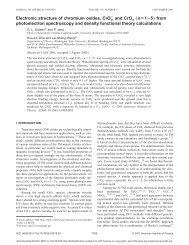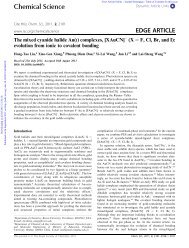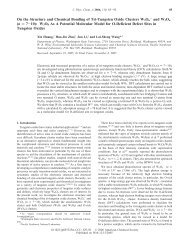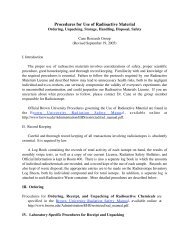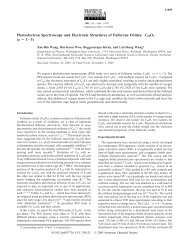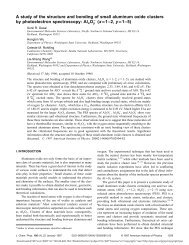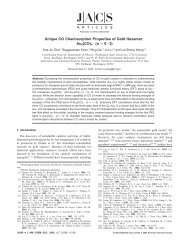Observation and Photoelectron Spectroscopic Study of Novel Mono ...
Observation and Photoelectron Spectroscopic Study of Novel Mono ...
Observation and Photoelectron Spectroscopic Study of Novel Mono ...
Create successful ePaper yourself
Turn your PDF publications into a flip-book with our unique Google optimized e-Paper software.
5296 J. Am. Chem. Soc. 1996, 118, 5296-5301<strong>Observation</strong> <strong>and</strong> <strong>Photoelectron</strong> <strong>Spectroscopic</strong> <strong>Study</strong> <strong>of</strong> <strong>Novel</strong><strong>Mono</strong>- <strong>and</strong> Diiron Oxide Molecules: FeO y- (y ) 1-4) <strong>and</strong>Fe 2 O y- (y ) 1-5)Hongbin Wu, Sunil R. Desai, <strong>and</strong> Lai-Sheng Wang*Contribution from the Department <strong>of</strong> Physics, Washington State UniVersity,Richl<strong>and</strong>, Washington 99352, <strong>and</strong> EnVironmental Molecular Sciences Laboratory, PacificNorthwest National Laboratory, MS K2-14, P.O. Box 999, Richl<strong>and</strong>, Washington 99352ReceiVed December 11, 1995 XAbstract: We study novel iron oxide molecules involving one <strong>and</strong> two iron atoms by anion photoelectron spectroscopyat 3.49 <strong>and</strong> 4.66 eV photon energies. Vibrationally resolved photoelectron spectra <strong>and</strong> low-lying excited states areobtained for FeO y - (y ) 1-4) <strong>and</strong> Fe 2 O y - (y ) 1-5). In both series, the photoelectron spectra become particularlysharp <strong>and</strong> better resolved for the higher oxides, FeO 3 - , FeO 4 - ,Fe 2 O 4 - , <strong>and</strong> Fe 2 O 5 - . The electron affinity <strong>of</strong> theneutral oxide molecules is observed to increase with the number <strong>of</strong> oxygen atoms, suggesting a sequential oxidationbehavior. For the monoiron oxide series, an oxidation saturation is observed as evidenced by the leveling-<strong>of</strong>f <strong>of</strong> theelectron affinity from FeO 3 to FeO 4 . The structures <strong>and</strong> chemical bonding <strong>of</strong> these oxide molecules are discussedbased on the sequential oxidation behavior. Isomers involving possibly O 2 or O 3 complexes are also observed forthe diiron oxides above Fe 2 O.IntroductionThe interaction between oxygen <strong>and</strong> iron is one <strong>of</strong> the mostimportant chemical processes both due to the importance <strong>of</strong> ironas oxygen carriers in biological systems <strong>and</strong> due to its relevanceto corrosion. Despite the wide interest in the iron-oxygensystems, few iron oxide molecules have been observed <strong>and</strong>studied. The FeO monoxide is one <strong>of</strong> the most studied <strong>and</strong>well-understood iron oxide species. 1-8 Even though manystudies have been directed at the FeO 2 species 1,9-16 due to itsrelevance to oxygen transport in biological systems, 17 its trueground state structure <strong>and</strong> electronic structure are still notcompletely understood. There have been few observations <strong>of</strong>the higher monoiron oxides 10,11 <strong>and</strong> little underst<strong>and</strong>ing <strong>of</strong> theirstructure <strong>and</strong> bonding.Diiron oxo complexes are common structural motif in a class<strong>of</strong> metalloproteins that are important as oxygen carriers <strong>and</strong>(1) Fan, J.; Wang, L. S. J. Chem. Phys. 1995, 102, 8714-8717.(2) Merer, A. J. Annu. ReV. Phys. Chem. 1989, 40, 407-438.(3) Dolg, M.; Wedig, U., Stoll, H.; Preuss, H. J. Chem. Phys. 1987, 86,2123-2131.(4) Andersen, T.; Lykke, K. R.; Neumark, D. M.; Lineberger, W. C. J.Chem. Phys. 1987, 86, 1858-1867.(5) Krauss, M.; Stevens, W. J. J. Chem. Phys. 1985, 82, 5584-5596.(6) Taylor, A. W.; Cheung, A. S-C.; Merer, A. J. J. Mol. Spectrosc. 1985,113, 487-494.(7) Engelking, P. C.; Lineberger, W. C. J. Chem. Phys. 1977, 66, 5054-5058.(8) Bagus, P. S.; Preston, H. J. T. J. Chem. Phys. 1973, 59, 2986-3002.(9) Andrews, L.; Chertihin, G. V.; Ricca, A.; Bauschlicher, C. W. J.Am. Chem. Soc. 1996, 118, 467-470.(10) Schroder, D.; Fiedler, A.; Schwarz, J.; Schwarz, H. Inorg. Chem.1994, 33, 5094-5100.(11) Fanfarillo, M.; Cribb, H. E.; Downs, A. J.; Greene, T. M.; Almond,M. J. Inorg. Chem. 1992, 31, 2962-2979.(12) Newton, J. E.; Hall, M. B. Inorg. Chem. 1984, 23, 4627-4632.(13) Blyholder, G.; Head, J.; Ruette, F. Inorg. Chem. 1982, 21, 1539-1545.(14) Chang, S.; Blyholder, G.; Fern<strong>and</strong>ez, J. Inorg. Chem. 1981, 20,2813-2817.(15) Reed, C. A.; Cheung, S. K. Proc. Natl. Acad. Sci. U.S.A. 1977, 74,1780-1784.(16) Hilderbr<strong>and</strong>, D. L. Chem. Phys. Lett. 1975, 34, 352-354.(17) Chem. ReV. 1994, 94, 567-856; Special issue on metal-dioxygencomplexes.S0002-7863(95)04153-9 CCC: $12.00methane oxygenases. 18,19 Many inorganic complexes containingdiiron oxo groups have been synthesized <strong>and</strong> characterized. 20-24However, few diiron oxide molecules 25-27 have been studiedin the isolated form even though such studies may provideessential insight into the electronic <strong>and</strong> chemical bondingproperties <strong>of</strong> the molecules <strong>and</strong> the complexes containing them.In the present contribution, we report the first systematic study<strong>of</strong> two series <strong>of</strong> iron oxide molecules (FeO y , y ) 1-4; Fe 2 O y ,y ) 1-5) using anion photoelectron spectroscopy at both 3.49<strong>and</strong> 4.66 eV photon energies. Vibrationally resolved photoelectronspectra <strong>and</strong> low-lying excited states are obtained forall the species. These two series <strong>of</strong> molecules can be viewedas sequential oxidation <strong>of</strong> the iron atom <strong>and</strong> the iron dimer. Adirect correlation is observed between the oxidation state <strong>of</strong> theiron atoms <strong>and</strong> the electron affinity <strong>of</strong> the oxide molecules. Wefind that for the monoiron series the electron affinity <strong>of</strong> the oxidemolecules increases with the number <strong>of</strong> oxygen atoms <strong>and</strong> levels<strong>of</strong>f from FeO 3 to FeO 4 . For the diiron series, the EA increasesmonotonically through the full range <strong>of</strong> oxygen content studiedhere. Isomers with low electron affinity are also observed forthe diiron series. Important bonding <strong>and</strong> structural informationis obtained <strong>and</strong> discussed based on the experimental observation.(18) Murch, B. P.; Boyle, P. D.; Que, L. J. Am. Chem. Soc. 1985, 107,6728-6729.(19) Rosenzweig, A. C.; Lippard, S. J. Acc. Chem. Res. 1994, 27, 229-236.(20) Zang, Y.; Dong, Y.; Que, L.; Kauffmann, K.; Munck, E. J. Am.Chem. Soc. 1995, 117, 1169-1170.(21) Powell, A. K.; Heath, S. L.; Gatteschi, D.; Pardi, L.; Sessoli, R.;Spina, G.; Del Giallo, F.; Pierralli, F. J. Am. Chem. Soc. 1995, 117, 2491-2502.(22) Micklitz, W.; McKee, V.; Rardin, R. L.; Pence, L. E.; Papaefthymiou,G. C.; Bott, S. G.; Lippard, S. J. J. Am. Chem. Soc. 1994, 116, 8061-8069.(23) Taft, K. L.; Papaefthymiou, G. C.; Lippard, S. J. Science 1993, 259,1302-1305.(24) Murch, B. P.; Bradley, F. C.; Boyle, P. D.; Papaefthymiou, V.; Que,L. J. Am. Chem. Soc. 1987, 109, 7993-8003.(25) Jacobson, D. B.; Freiser, B. S. J. Am. Chem. Soc. 1986, 108, 27-30.(26) Loh, S. K.; Lian, L.; Armentrout, P. B. J. Chem. Phys. 1989, 91,6148-6156.(27) Wang, L. S.; J. Fan; Lou, L. Sur. ReV. Lett. 1995, in press.© 1996 American Chemical Society
<strong>Mono</strong>- <strong>and</strong> Diiron Oxide Molecules J. Am. Chem. Soc., Vol. 118, No. 22, 1996 5297The systematic study allows insight to be obtained into thenature <strong>of</strong> the chemical bonding <strong>of</strong> iron that possesses multipleoxidation states. Some <strong>of</strong> the diiron oxides are found to bestructurally similar to those known in diiron oxo complexes.Experimental SectionThe experimental apparatus used for this study has been describedin detail elsewhere. 28,29 Briefly, it couples a laser vaporization clustersource with a magnetic bottle time-<strong>of</strong>-flight photoelectron analyzer. 30An intense pulsed laser beam is focused onto a pure iron target,producing a plasma containing iron atoms in both charged <strong>and</strong> neutralstates. A helium carrier gas, seeded with 0.5% O 2 <strong>and</strong> delivered bytwo pulsed molecular beam valves, is mixed with the plasma. Thereactions between the iron atoms <strong>and</strong> the oxygen produce the desiredFe xO y- clusters. The helium carrier gas <strong>and</strong> the oxide clusters undergoa supersonic expansion, forming a cold <strong>and</strong> collimated molecular beamby two skimmers. The negative clusters are extracted at 90° from thebeam <strong>and</strong> subjected to a time-<strong>of</strong>-flight mass analysis. The clusters <strong>of</strong>interest are mass selected <strong>and</strong> decelerated before photodetachment bya pulsed laser beam. The detachment laser beam from a Nd:YAG laser(355 or 266 nm, 7 ns pulse width) is not focused <strong>and</strong> has a5mmdiameter spot size in the detachment zone defined by an aperture outsidethe vacuum chamber. Typically, a pulse energy between 0.5-5 mJisused, corresponding to a laser fluence <strong>of</strong> 2.5-25 mJ/cm 2 . A higherlaser fluence is used at 355 nm to obtain a stronger photoelectron signal.Lower fluences are used for the 266 nm to reduce low energy noisesdue to scattered photons interacting with surfaces near the detachmentzone.All the 355 nm spectra are taken at 10 Hz repetition rate, while the266 nm spectra are taken at 20 Hz with the vaporization laser <strong>of</strong>f atalternating shots for background subtraction. Nearly 100% <strong>of</strong> thephotoelectrons are collected by the magnetic bottle <strong>and</strong> are parallelizeddown to a 3.5 m long time-<strong>of</strong>-flight tube for electron kinetic energyanalyses. The current version <strong>of</strong> the magnetic bottle uses a permanentmagnet for the high field 29 <strong>and</strong> has an energy resolution ranging from20 to 30 meV at 1 eV electron kinetic energy. The best resolution is<strong>of</strong>ten achieved right after a fresh bake <strong>of</strong> the spectrometer <strong>and</strong>deteriorates somewhat with time, mostly caused by the change <strong>of</strong>workfunction <strong>of</strong> the vacuum chambers due to the chemisorption <strong>of</strong>oxygen. The electron kinetic energy distributions are calibrated withthe known spectrum <strong>of</strong> the Cu - anion <strong>and</strong> are subtracted from thephoton energies to obtain the presented electron binding energy spectra.ResultsFigure 1 shows the photoelectron spectra <strong>of</strong> FeO - y (y ) 1-4)at 4.66 eV photon energy. The spectra <strong>of</strong> Fe 2 O - y (y ) 1-5)are displayed in Figure 2. Vibrational structures are resolvedin most <strong>of</strong> the spectra, <strong>and</strong> they are particularly well resolvedfor the higher oxides, which also appear to have simpler spectra.These spectra represent transitions from the ground state <strong>of</strong> theanion to the ground <strong>and</strong> excited states <strong>of</strong> the neutrals. The broadfeatures at the lower binding energy side in the spectra <strong>of</strong> Fe 2 O- 2<strong>and</strong> Fe 2 O - 3 are most likely due to isomers (see below). Severalelectronic excited states are observed for FeO. Only one excitedstate is observed for most <strong>of</strong> the other species. These are labeledin the figures. The observed energies <strong>and</strong> spectroscopicconstants for the FeO y <strong>and</strong> Fe 2 O y molecules are listed in Tables1 <strong>and</strong> 2, respectively.The adiabatic electron affinity (EA) <strong>of</strong> the neutral moleculescan be determined fairly accurately from the binding energy <strong>of</strong>the ν ) 0 vibrational feature when vibrational structure isresolved for the ground state. The EA values are represented(28) Wang, L. S.; Cheng, H. S.; Fan, J. J. Chem. Phys. 1995, 102, 9480-9493.(29) Wu, H.; Desai, S. R.; Wang, L. S. J. Chem. Phys. 1995, 103, 4363-4366.(30) Kruit, P.; Read, F. H. J. Phys. E: Sci. Instrum. 1983, 16, 313-324. Cheshnovsky, O.; Yang, S.; Pettiette, C. L.; Craycraft, M. J.; Smalley,R. E. ReV. Sci. Instrum. 1987, 58, 2131-2129.Figure 1. <strong>Photoelectron</strong> spectra <strong>of</strong> FeO y- (y ) 1-4) at 4.66 eV photonenergy. The vertical lines indicate the resolved vibrational structures.“X” represents the ground state <strong>of</strong> the neutrals <strong>and</strong> the other lettersrepresent the exited states. Note the sharp, well-resolved <strong>and</strong> rathersimilar spectra for FeO 3- <strong>and</strong> FeO 4- .in Tables 1 <strong>and</strong> 2 by the binding energy <strong>of</strong> the ground state. Itis seen clearly that the EA increases with the number <strong>of</strong> oxygenatoms in both oxide series. The EA appears to level <strong>of</strong>f fromFeO 3 to FeO 4 for the monoiron series. These are plotted inFigure 3 together with the EA values <strong>of</strong> the Fe atom 31 <strong>and</strong> theFe 2 dimer. 32The PES spectra usually do not depend on the detachmentlaser fluences. Thus a higher fluence is preferred to obtainstronger photoelectron signals. However, when photodissociation<strong>of</strong> the size-selected parent anion competes with photodetachment,the photoelectron spectra can vary with the detachmentlaser fluences because the negative phot<strong>of</strong>ragments canalso be detached by the same laser pulse. Such is the case forFeO - 4 . The spectrum shown in Figure 1 is taken at a very lowlaser fluence <strong>of</strong> about 1.5 mJ/cm 2 . At higher laser fluences,extra features at the lower binding energy side appear, as shownin Figure 4 taken at a laser fluence <strong>of</strong> 10 mJ/cm 2 , while themain features remain the same.DiscussionSequential Oxidation: Oxidation State versus ElectronAffinity. Our most interesting observation is shown in Figure3, which displays the relationship between the electron affinity<strong>and</strong> the number <strong>of</strong> oxygen atoms in the mono- <strong>and</strong> diiron oxidemolecules. The EA is a measure <strong>of</strong> the ability <strong>of</strong> the neutralmolecule to stabilize a negative charge in its ground state. For(31) Engelking, P. C.; Lineberger, W. C. Phys. ReV. A 1979, 19, 149-154.(32) Leopold, D. G.; Lineberger, W. C. J. Chem. Phys. 1986, 85, 51-55.
5298 J. Am. Chem. Soc., Vol. 118, No. 22, 1996 Wu et al.Table 2. Observed Energies <strong>and</strong> <strong>Spectroscopic</strong> Constants forFe 2O y (y ) 1-5) from the <strong>Photoelectron</strong> Spectra <strong>of</strong> the Anionsstate BE (eV) term value b (eV)vibrationalfreq b (cm -1 )Fe 2O X 1.63 (4) 0A 2.02 (6) 0.39 (3)Fe 2O 2 X 2.36 (5) 0 670 (70)A 2.80 (7) a 0.44 (5)Fe 2O 3 X 3.06 (4) 0 810 (100)A 3.31 (7) a 0.25 (5) 650 (80)Fe 2O 4 X 3.56 (4) 0 710 (60)A 3.74 (4) 0.18 (2) 720 (60)aEstimated binding energy. The spectrum is complicated by thepresence <strong>of</strong> another isomer. b Relative energies can be determined moreaccurately.Figure 3. The electron affinity <strong>of</strong> the mono- <strong>and</strong> diiron oxide moleculesversus the number <strong>of</strong> O atoms.Figure 2. <strong>Photoelectron</strong> spectra <strong>of</strong> Fe 2O y- (y ) 1-5). The spectra <strong>of</strong>Fe 2O - <strong>and</strong> Fe 2O 2- are taken at 3.49 eV photon energy while that <strong>of</strong>the higher oxides are taken at 4.66 eV. The vertical lines indicate theresolved vibrational structures. “X” represents the ground state <strong>of</strong> theneutrals <strong>and</strong> “A” represents the exited states. The “?” in the spectra <strong>of</strong>Fe 2O 2- <strong>and</strong> Fe 2O 3- indicates features <strong>of</strong> possible isomers, thatcomplicate the spectra. Note the sharp <strong>and</strong> well-resolved spectra forFe 2O 4- <strong>and</strong> Fe 2O 5- .Table 1. Observed Energies <strong>and</strong> <strong>Spectroscopic</strong> Constants for FeO y(y ) 1-4) from the <strong>Photoelectron</strong> Spectra <strong>of</strong> the Anionsstate BE (eV) term value b (eV)vibrationalfreq b (cm -1 )FeO X 1.50 (4) 0 950 (80)A 1.98 (4) 0.48 (2)B 2.36 (4) 0.86 (2)C 2.56 (4) 1.06 (2) 800 (60)D 3.39 (6) 1.89 (3) 850 (90)FeO 2 X 2.36 (3) 0A 3.31 (6) a 0.95 (4)FeO 3 X 3.26 (4) 0 850 (50)aEstimated adiabatic binding energy. The vertical binding energyis 3.46 eV as determined from the b<strong>and</strong> maximum. b Relative energiescan be determined more accurately.the iron oxide molecules, substantial ionic bonding character isexpected because the O atom is much more electronegative.Therefore, the extra charge should be localized on the iron atomsbecause in the neutral form the Fe atoms are expected to beslightly positively charged. On the basis <strong>of</strong> this simple ionicpicture, the nearly linear increase <strong>of</strong> the EA with the number<strong>of</strong> oxygen atoms suggests that the charge transfer for thesubsequent oxygen addition is approximately equal. Thus, thelinear relation between the EA <strong>and</strong> the number <strong>of</strong> O atomssuggests a sequential oxidation process.If we use the formal oxidation state <strong>of</strong> -2 for the O atom,then each O addition increases the oxidation state <strong>of</strong> the Featom by +2 in the monoiron series <strong>and</strong> by +1 in the diironseries. The maximum known oxidation state for the Fe atomis +6, which is reached in FeO 3 . Thus, one more O additionwill not be able to further oxidize the Fe atom, i.e., an oxidationsaturation. This explains perfectly the leveling-<strong>of</strong>f <strong>of</strong> the EAfrom FeO 3 to FeO 4 , implying that there must be an O-O bondin FeO 4 . For the diiron series, this maximum oxidation state isstill not achieved even at Fe 2 O 5 (+5). This suggests that theEA should further increase with further addition <strong>of</strong> an O atomto Fe 2 O 6 . Unfortunately, the signal for the Fe 2 O - 6 mass fromour cluster source was too weak for it to be studied here.We have found similar oxidation behavior for other metaloxide cluster series as well. 29,33 However, no such linear relationis observed for the silicon oxide cluster series, 34,35 which arecovalent-bonded molecules. Therefore, the linear EA increasewith O atoms is a strong indicator <strong>of</strong> ionic bonding, characteristic<strong>of</strong> metal oxides. This will be important in our laterdiscussion <strong>of</strong> the structures <strong>of</strong> these oxide molecules.Electronic <strong>and</strong> Geometric Structures <strong>of</strong> the <strong>Mono</strong>ironOxides: FeO y (y ) 1-4). We have reported the photoelectronspectra <strong>of</strong> FeO - <strong>and</strong> FeO - 2 recently at 3.49 eV photon energy. 1We refer the readers to the previous work for a more extensivediscussion <strong>and</strong> assignment <strong>of</strong> the lower-lying states accessedat the 3.49 eV photon energy. Only the new features observedat the present higher photon energy will be discussed here. Sincethe electronic structure <strong>of</strong> FeO is well understood, it also serveshere as a good starting point to discuss the higher oxides. Thecurrent FeO - <strong>and</strong> FeO - 2 spectra shown in Figure 1 are takenat 4.66 eV at a slightly reduced resolution due to higher electron(33) Wang, L. S.; Wu, H.; Desai, S. R.; Lou, L. Phys. ReV. B1996, 53,8028-8031.(34) Fan, J.; Nicholas, J. B.; Price, J. M.; Colson, S. D.; Wang, L. S. J.Am. Chem. Soc. 1995, 117, 5417-5418.(35) Wang, L. S.; Nicholas, J. B.; Wu, H.; Desai, S. R.; Colson, S. D.,to be published.
<strong>Mono</strong>- <strong>and</strong> Diiron Oxide Molecules J. Am. Chem. Soc., Vol. 118, No. 22, 1996 5299Figure 6. Schematic drawing <strong>of</strong> the structures <strong>of</strong> the monoiron oxides.Note that the FeO 4 molecule contains an O-O unit.Figure 4. The photoelectron spectrum <strong>of</strong> FeO 4- taken at a higherdetachment laser fluence (10 mJ/cm 2 ), showing lower energy featuresdue to photodissociation <strong>of</strong> the parent FeO-4- anion (FeO 4- f FeO 2+ O 2).Figure 5. The schematic ordering <strong>and</strong> occupations <strong>of</strong> the molecularorbitals <strong>of</strong> the FeO molecule, showing that the O-derived orbitals liebelow those <strong>of</strong> the Fe 3d-derived orbitals.kinetic energies. One more excited state is observed for bothFeO <strong>and</strong> FeO 2 : feature D for FeO <strong>and</strong> feature A for FeO 2 aslabeled in Figure 1. There seem to be real signals at higherbinding energies in both spectra. But they do not appear to bewell defined due to strong noise in this spectral range <strong>and</strong> willnot be further discussed. We do not observe isomers for FeO- 2involving weakly bonded Fe/O 2 complexes as is observed in arecent matrix infrared experiment. 9 Such complexes shouldyield weak features at lower binding energies in the photoelectronspectrum because they are expected to have lower EA thanthe oxide. 29The FeO - spectrum exhibits a strong photon energy dependence.Notably, the A 5 Σ + peak is the strongest feature in the3.49 eV spectrum, while its intensity is substantially reducedwith respect to the other features at the higher photon energy.This indicates that its total photodetachment cross section isstrongly energy dependent. The molecular orbital (MO)diagram <strong>and</strong> ordering <strong>of</strong> FeO are shown schematically in Figure5. In the anion, the extra electron enters the 9σ orbital. 4,5 TheX, A, B, <strong>and</strong> C states have been assigned <strong>and</strong> discussed in detailbefore. 1 They result from removing an electron from the 9σ or1δ orbitals. The newly observed state, D, is assigned to befrom removing a 4π electron, resulting in a 3 Π state. The termvalue for this highly excited state is 1.89 eV. It has never beenobserved before since the transition between this state <strong>and</strong> theground state is spin-forbidden.It is important to note that all the spectral features observedfor FeO derive from the Fe 3d orbitals (the 9σ orbital is reallya spd hybrid). 5 The primarily O-derived orbitals (8σ <strong>and</strong> 3π)lie much deeper in energy <strong>and</strong> cannot be accessed at the photonenergies used currently. This is essential to underst<strong>and</strong> thespectra <strong>of</strong> the higher oxide molecules, in which more 3delectrons are transferred to the additional O atoms, resulting insimpler electronic structures for the higher oxide molecules. Thisis indeed the case, as evidenced in Figure 1 by the simplerspectra <strong>of</strong> the higher oxides. Only two states are observed ineach case for FeO 2 , FeO 3 , <strong>and</strong> FeO 4 . Compared to the FeOspectrum, all these features <strong>of</strong> the higher oxides should bederived mainly from the Fe 3d orbitals. However, more detailedelectronic assignments <strong>of</strong> these features are not possible withoutaccurate theoretical calculations because the occupation <strong>and</strong>ordering <strong>of</strong> the MOs cannot be determined a priori. We willfocus on the structural <strong>and</strong> bonding aspect for which significantinformation can be derived from the observed spectra.From the oxidation state concept discussed above, thereshould be no O-O bond in FeO 2 <strong>and</strong> FeO 3 . Each O atomshould form a formally FedO double bond with the Fe atom.This saturates the oxidation state <strong>of</strong> Fe (VI) at FeO 3 . Thereforeit is expected that there should be an O-O bond in FeO 4 ,implying that the electronic structure <strong>of</strong> FeO 4 should be similarto that <strong>of</strong> FeO 3 . This is evidenced by the similarity betweenthe photoelectron spectra <strong>of</strong> FeO - 3 <strong>and</strong> FeO - 4 <strong>and</strong> the fact thatthe EA <strong>of</strong> FeO 4 is also similar to that <strong>of</strong> FeO 3 . Another piece<strong>of</strong> evidence for the existence <strong>of</strong> an O-O bond in FeO 4 comesfrom the photodissociation <strong>of</strong> the FeO - 4 anion at high laserfluences, as shown in Figure 4. The broad feature near 2.3 eVis from photodissociation products that are further detached bythe same laser pulse. Among the possible dissociation products,the binding energy <strong>of</strong> that feature can be due to either FeO- 2or O - 3 . The O - 3 can be eliminated because a much strongerb<strong>and</strong> near 3.5 eV would be expected for O - 3 as well. 36 Weconclude that this broad feature is due to detachment <strong>of</strong> avibrationally hot FeO - 2 formed by an O 2 loss from FeO- 4(FeO - 4 f FeO - 2 + O 2 ). A previous mass spectrometric studyon the FeO - 4 anion also suggests that it has at least one intactO-O unit. 10The FeO 2 molecule has been more extensively studied. 9-16The most stable form has been concluded to be a bent OdFedOstructure with a bond angle <strong>of</strong> about 141 degree. 9 Our FeO- 2spectrum consists <strong>of</strong> two broad features without vibrationalstructure, suggesting excitation <strong>of</strong> the low frequency bendingmode. This is consistent with a bent structure for FeO 2 , thathas a rather low bending frequency. There have been fewstudies on the FeO 3 <strong>and</strong> FeO 4 molecules before. A previousmatrix study suggested that a D 3h FeO 3 was observed. 11 Thecalculated symmetric stretching frequency for the D 3h FeO 3 is792 cm -1 . Our photoelectron spectrum for FeO - 3 is surprisinglysimple with well-resolved vibrational structures for both theobserved states (X <strong>and</strong> A). The observed vibrational frequencyis about 850 cm -1 for both states, in reasonable agreement withthe previous calculated symmetric stretching frequency for theD 3h FeO 3 . The simple photoelectron spectrum also agrees witha highly symmetric FeO 3 <strong>and</strong> that there is only very slightgeometry change along the Fe-O stretching coordinate. Therather high Fe-O stretching frequency in FeO 3 suggests thatthe Fe-O bonds are quite strong, comparable to that in the FeOmonoxide. Therefore, we conclude that our observed FeO 3 isdue to the D 3h FeO 3 with three FedO bonds.The photoelectron spectra <strong>of</strong> FeO - 4 <strong>and</strong> FeO - 3 are surprisinglysimilar except that there is more extensive vibrationalexcitation in the FeO - 4 spectra. The vibrational frequency inthe ground state <strong>of</strong> FeO 4 is even higher than that in FeO 3 . Thefact that FeO 4 has a similar EA suggests that the Fe atom inFeO 4 has a similar oxidation state as in FeO 3 , as mentionedabove. The similar photoelectron spectra imply they both havesimilar electronic structure. All these indicate that FeO 4 isformed simply by replacing an O atom in FeO 3 with an O-Ounit while maintaining a similar bonding character. It follows(36) Arnold, D. W.; Xu, C.; Kim, E. H.; Neumark, D. M. J. Chem. Phys.1994, 101, 912-922.
5300 J. Am. Chem. Soc., Vol. 118, No. 22, 1996 Wu et al.that the FeO 4 molecule should contain two FedO bonds <strong>and</strong>an O-O unit bonded to the Fe atom. The O-O bond is mostlikely perpendicular to the FeO 2 plane, resulting in a C 2V FeO 4 .The structures <strong>of</strong> the FeO y (y ) 1-4) molecules are summarizedin Figure 6, which shows clearly in the formal sense the increase<strong>of</strong> the oxidation state <strong>of</strong> Fe from +2 in FeO to +6 inFeO 3 aswell as in FeO 4 .Electronic <strong>and</strong> Geometric Structures <strong>of</strong> the Diiron Oxides:Fe 2 O y (y ) 1-5). The most striking feature <strong>of</strong> the diironoxide series is the observation <strong>of</strong> the prominent ground statepeak in all the molecules except Fe 2 O - 2 <strong>and</strong> Fe 2 O - 3 , wherebroader features are observed at lower binding energies alongwith the prominent features. Similar to the monoiron series,the spectra become quite sharp <strong>and</strong> simple for the higher oxideswith well-resolved vibrational structures. The broad featuresat the lower binding energy side in the spectra <strong>of</strong> Fe 2 O - 2 <strong>and</strong>Fe 2 O - 3 are assigned to other isomers, possibly involving intactO-O unit. This will be discussed later. The reasons for thisassignment are as follows: (1) They are not due to photodissociationbecause their intensities do not depend on the laserfluences or wavelengths (355 <strong>and</strong> 266 nm). (2) The systematicsharp <strong>and</strong> prominent peaks observed in all the spectra are quitesimilar. The increase <strong>of</strong> EA with the number <strong>of</strong> O atoms hasnow been observed in several transition metal oxide clustersystems <strong>and</strong> seems to be general in metal oxide clusters. Thebroad low energy feature in the Fe 2 O - 2 spectrum clearly doesnot fit with this general trend. (3) Similar broad features at thelower binding energy side can also be discerned for the Fe 2 O- 4<strong>and</strong> Fe 2 O - 5 spectra but at a much lower signal level (Figure 2).These broad features can be clearly observed at 3.49 eV photonenergy, suggesting that similar isomers also exist for Fe 2 O- 4<strong>and</strong> Fe 2 O - 5 at a much lower abundance. In the following wediscuss the main oxide series first, then the possible isomers.The EA vs O atom trend for the diiron series is similar tothe monoiron series, suggesting that this series can be viewedas a sequential oxidation <strong>of</strong> the Fe 2 dimerseach O atom isindividually bonded to the two Fe atoms with a similar amount<strong>of</strong> charge transfer. Our previous study <strong>of</strong> single O atomadsorption on small iron clusters predicted that Fe 2 OhasaC 2Vtriangle structure with a bridging O atom. 27 There have beenfew other studies on any <strong>of</strong> these diiron oxide molecules 25,26except that a rhombus Fe 2 O 2 unit has been seen in a number <strong>of</strong>organometallic complexes. 20-24 Therefore, detailed assignments<strong>of</strong> the observed electronic states will not be attempted at thepresent time <strong>and</strong> only qualitative structure <strong>and</strong> bonding aspects<strong>of</strong> these molecules are discussed. The best way to underst<strong>and</strong>the electronic structure <strong>of</strong> these oxides is to start from the Fe 2dimer <strong>and</strong> to compare with the monoiron oxides discussedabove.The Fe 2 ground state configuration may be described as (3d 14 )σ 2 4s , where 3d 14 represents collectively the MOs formed fromthe 3d atomic orbitals <strong>and</strong> σ 2 4s represents the σ bonding orbitalbetween the Fe atoms. 37 Analogous to the monoiron oxideseries, when Fe 2 is oxidized the O-derived orbitals lie belowthe Fe 3d-derived orbitals (see Figure 5), formally resulting ina charge transfer <strong>of</strong> two electrons from Fe 2 to the O atom.Subsequent oxidation will result in more charge transfer fromthe Fe 2 to the O atoms; each O addition increases formally theoxidation state <strong>of</strong> the Fe atoms by +1. The observed spectralfeatures should all be derived from the orbitals involving theFe atoms. Similar to the monoiron series, the increased chargetransfer from the Fe atoms to the O atoms explains the fact that(37) Noro, T.; Ballard, C.; Palmer, M. H.; Tatewaki, H. J. Chem. Phys.1994, 100, 452-458. Leopold, D. G.; Alml<strong>of</strong>, J.; Lineberger, W. C.; Taylor,P. R. J. Chem. Phys. 1988, 88, 3780-3783. Tomonari, M.; Tatewaki, H. J.Chem. Phys. 1988, 88, 1828-1836.Figure 7. Schematic drawing <strong>of</strong> possible structures for the diiron oxidemolecules, consistent with the sequential oxidation concept. For thehypothetical structure <strong>of</strong> Fe 2O 6, the four terminal O atoms <strong>and</strong> the twobridging O atoms are on perpendicular planes.the electronic structure <strong>of</strong> the higher oxides appears to besimplified, as evidenced by the seemingly simpler photoelectronspectra. From the rather high observed vibrational frequencies,the interactions between the Fe <strong>and</strong> O atoms are strengthenedat the higher oxides. The rather sharp spectral features suggestthat the detached electrons are from non-bonding or weaklybonding orbitals, which are consistent with the nature <strong>of</strong> the Fe3d-derived orbitals.The spectra <strong>of</strong> the diiron oxide species are quite similar, eachwith a prominent ground state peak <strong>and</strong> a lower intensity excitedstate peak. There is also a second exited state peak for Fe 2 Oatabout 2.8 eV that is partially overlapped with the A state. Thespectra <strong>of</strong> Fe 2 O - 2 <strong>and</strong> Fe 2 O - 3 are obviously complicated bythe existence <strong>of</strong> isomers that have substantial abundance. Thespectra <strong>of</strong> Fe 2 O - 4 <strong>and</strong> Fe 2 O - 5 are best resolved, each with oneexcited state. These two spectra are also very similar, exceptthat Fe 2 O 5 has a higher EA <strong>and</strong> higher vibrational frequenciesin both the ground <strong>and</strong> excited states.On the basis <strong>of</strong> the above discussions, it is interesting tospeculate about the possible structures <strong>of</strong> these diiron oxides.These are shown in Figure 7. All the structures are consistentwith the sequential oxidation concept, <strong>and</strong> the oxidation states<strong>of</strong> the Fe atoms can be counted by the bonds they form with Oatoms, <strong>and</strong> they increase sequentially from +1 inFe 2 Oto+5in Fe 2 O 5 . The oxidation state <strong>of</strong> Fe is still not saturated atFe 2 O 5 . This is also obvious from the EA vs O atom curveshown in Figure 3. We predict that there should be a stableFe 2 O 6 molecule, whose possible structure is also included inFigure 7.The C 2V triangle structure for the Fe 2 O is known from ourprevious work. 27 The only reasonable structure for Fe 2 O 2 isthe rhombus structure, which is known to occur in severalorganometallic compounds. 20-24 Several other M 2 O 2 oxides areknown to possess the rhombus structure, including Cu 2 O 2 , 33Si 2 O 2 , 38 <strong>and</strong> Ge 2 O 2 . 39 The Fe 2 O 3 molecule may have severalpossible structures. The one shown in Figure 7 with threebridging O atoms is the only one with three equivalent O atoms.Cu 2 O 3 is also found to have a similar structure. 33 The structures<strong>of</strong> Fe 2 O 4 <strong>and</strong> Fe 2 O 5 can be viewed to be built upon the structures<strong>of</strong> Fe 2 O 2 <strong>and</strong> Fe 2 O 3 , respectively, each with two more FedOdouble bonds. The valence <strong>of</strong> the Fe atoms is better satisfiedin the higher oxides, strengthening the overall Fe-O bondingas evidenced by their higher vibrational frequencies. Accuratetheoretical calculations are required to definitely solve thestructures <strong>of</strong> the higher oxide molecules. The present experimentsprovide some stringent parameters to compare withtheoretical calculations that can also undoubtedly yield moreinsight into the nature <strong>of</strong> the chemical bonding in these unusualoxide molecules.Finally, it is interesting to discuss the possible isomersobserved for the Fe 2 O 2 <strong>and</strong> Fe 2 O 3 molecules. Since the EA <strong>of</strong>the Fe 2 O 2 isomer is not increased compared to Fe 2 O, it mustinvolve an O-O bond. Most likely, it consists <strong>of</strong> a Fe 2 -O 2
<strong>Mono</strong>- <strong>and</strong> Diiron Oxide Molecules J. Am. Chem. Soc., Vol. 118, No. 22, 1996 5301complex. The Fe 2 O 3 isomer may consist <strong>of</strong> a Fe 2 O-O 2complex or Fe 2 -O 3 complex. Similarly, the Fe 2 O 4 <strong>and</strong> Fe 2 O 5isomers may also consist <strong>of</strong> O 2 or O 3 units. All these isomersseem to yield rather broad features in the photoelectron spectra,consistent with their weakly bound nature. In some sense, theseO 2 complexes may be more interesting because they may mimicthe properties <strong>of</strong> those O 2 complexes formed in oxygen transportsystems or organometallic-O 2 complexes, that are precursorsfor the cleaving <strong>of</strong> the O-O bond. 17SummaryWe study two series <strong>of</strong> novel iron oxide molecules, FeO y (y) 1-4) <strong>and</strong> Fe 2 O y (y ) 1-5), using anion photoelectronspectroscopy. Important electronic <strong>and</strong> vibrational structuresare obtained, providing unique information about the structures<strong>and</strong> bonding <strong>of</strong> these molecules. For both series, sequentialoxidation behaviors are observed, as inferred from the near linearincrease <strong>of</strong> the electron affinity versus the number <strong>of</strong> O atoms.An oxidation saturation is observed at FeO 3 , consistent withthe known maximum oxidation state <strong>of</strong> the Fe atom. In bothseries, the photoelectron spectra are observed to become simpleras the number <strong>of</strong> O atoms increases. This is consistent with acharge transfer picture where the electrons are sequentiallytransferred from the Fe atoms to the increasing O atoms, yieldinga simpler electronic structure for the higher oxides because theO-derived orbitals all lie deeper in energy <strong>and</strong> cannot beaccessed by the photon energies used. The structures <strong>of</strong> the(38) Goldberg, N.; Iraqi, M.; Koch, W.; Schwarz, H. Chem. Phys. Lett.1994, 225, 404-409. Bencivenni, L.; Pelino, M.; Ramondo, F. J. Mol.Struct. (Theochem) 1992, 253, 109-120. Snyder, L. C.; Raghavachari, K.J. Chem. Phys. 1984, 80, 5076-5079.(39) Nicholas, J. B.; Fan, J.; Wu, H.; Colson, S. D.; Wang, L. S. J. Chem.Phys. 1995, 102, 8277-8280.monoiron series are found to change from a C 2V FeO 2 to a D 3hFeO 3 , <strong>and</strong> finally to a C 2V FeO 4 that contains an O-O bondsince the oxidation state <strong>of</strong> Fe is already saturated at FeO 3 . ThatFeO 4 must contain an O-O unit is also evidenced by observation<strong>of</strong> photodissociation <strong>of</strong> the parent FeO - 4 anion, which canlose an O 2 under high laser fluences to give rise to a broadFeO - 2 feature. For the diiron series, all the spectra are observedto be quite similar, each containing a rather prominent groundstate peak, followed by one or two excited state features.Isomers are also observed for the Fe 2 O - y series when y > 1.These isomers are particularly abundant for Fe 2 O - 2 <strong>and</strong> Fe 2 O- 3<strong>and</strong> complicate the observed spectra. These isomers areproposed to be complexes involving O 2 or O 3 units. For themain oxide sequence, the electron affinity is observed to increasewith the number <strong>of</strong> O atoms. The oxidation is observed not tobe saturated at Fe 2 O 5 , agreeing with the maximum knownoxidation state <strong>of</strong> the Fe atom. Possible structures are proposedfor these oxide molecules, consistent with the experimentalobservations, which provide stringent tests for any theoreticalcalculations that can more completely elucidate the structure<strong>and</strong> bonding <strong>of</strong> these novel oxide molecules.Acknowledgment. We thank Dr. L. Lou for valuablediscussions <strong>and</strong> Pacific Northwest National Laboratory/U.S.Department <strong>of</strong> Energy, Basic Energy Sciences for the development<strong>of</strong> the cluster-PES apparatus. Support for this study fromthe National Science Foundation (Grant No. CHE-9404428) isgratefully acknowledged. This work was performed at PacificNorthwest National Laboratory, operated for the U.S. Department<strong>of</strong> Energy by Battelle under contract DE-AC06-76RLO1830.JA954153B



